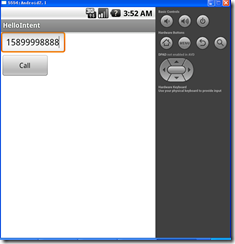Android学习笔记(7):Hello Intent
2012-12-30 13:12 ps_zw 阅读(677) 评论(0) 编辑 收藏 举报前言
在前面介绍过Activity,Service时,我们已经涉及到了Intent,这里做一点补充介绍。
本文要点:
1.Intent简介
2.Intent Filter简介
一、Intent简介
1.Intent是什么
一个Android应用中,主要是由四种组件组成的。这四种组件本身是相互独立的,那么我们就需要一种机制让这些组件可以相互通讯,相互调用。Intent正好就充当了这么一个角色。Intent在这里起着一个媒体中介的作用,专门提供组件互相调用的相关信息,实现调用者与被调用者之间的解耦。
2.Intent属性
Intent对象,属性包括了Action,Data,Category,Extras,Type等。结合一个例子,我们来介绍下Intent的相关属性。
一个简单拨号程序:
main.xml
<LinearLayout xmlns:android="http://schemas.android.com/apk/res/android" android:layout_width="fill_parent" android:layout_height="fill_parent" android:orientation="vertical" > <EditText android:id="@+id/txtPhoneNumber" android:hint="Enter number" android:layout_width="wrap_content" android:layout_height="wrap_content"/> <Button android:id="@+id/btnCall" android:layout_width="wrap_content" android:layout_height="wrap_content" android:width="100dp" android:text="Call" android:onClick="callPhoneNumber"/> </LinearLayout>
MainActivity.java(注意方法callPhoneNumber(view)。)
1 package com.wzhang.hellointent; 2 3 import android.net.Uri; 4 import android.os.Bundle; 5 import android.app.Activity; 6 import android.content.Intent; 7 import android.view.Menu; 8 import android.view.View; 9 import android.widget.Button; 10 import android.widget.EditText; 11 12 public class MainActivity extends Activity { 13 14 @Override 15 protected void onCreate(Bundle savedInstanceState) { 16 super.onCreate(savedInstanceState); 17 setContentView(R.layout.main); 18 } 19 20 @Override 21 public boolean onCreateOptionsMenu(Menu menu) { 22 // Inflate the menu; this adds items to the action bar if it is present. 23 getMenuInflater().inflate(R.menu.main, menu); 24 return true; 25 } 26 27 //通过Intent来调用那些能够处理拨号行为的Activity 28 public void callPhoneNumber(View view){ 29 EditText txtPhoneNumber = (EditText) findViewById(R.id.txtPhoneNumber); 30 String phoneNumber = txtPhoneNumber.getText().toString(); 31 32 //new Intent(action,data); 33 Intent intent = new Intent(Intent.ACTION_DIAL,Uri.parse("tel://"+phoneNumber)); 34 //调用可拨号的那些Activity 35 startActivity(intent); 36 } 37 }
运行效果:
点击按钮:
结合给定的实例,我们了解一些Intent属性:
Action:字符串,是对所将执行的动作的描述,在Intent类中定义了一些字符串常量作为标准动作。如:例子中的Intent.ACTION_DIAL,我们也可以自定义Action,并定义相应的Activity来处理我们自定义的行为;常用的Action有如 ACTION_VIEW, ACTION_EDIT等。
Data:是对执行动作所要操作的数据的描述,Android中采用URI来表示数据,如:”tel://15899998888”。
在官网API上,结合Action和Data给了一些例子:
ACTION_VIEWcontent://contacts/people/1 -- Display information about the person whose identifier is "1".ACTION_DIALcontent://contacts/people/1 -- Display the phone dialer with the person filled in.ACTION_VIEWtel:123 -- Display the phone dialer with the given number filled in. Note how the VIEW action does what what is considered the most reasonable thing for a particular URI.ACTION_DIALtel:123 -- Display the phone dialer with the given number filled in.
Category:类别,是被请求组件的额外描述信息,Intent类中也定义了一组字符串常量表示Intent不同的类别,同样官网API上也有几个例子:
CATEGORY_LAUNCHERmeans it should appear in the Launcher as a top-level application,whileCATEGORY_ALTERNATIVEmeans it should be included in a list of alternative actions the user can perform on a piece of data.
Extras:附加信息,extra属性使用Bundle类型进行数据传递,附加数据可以通过 intent.putExtras() 和 intent.getExtras() 进行传入和读取。如:
1 //这两段代码来自前面HelloActivity中的示例代码 2 3 //MainActivity中的发送消息代码 4 public void sendMessage(View view){ 5 Intent intent = new Intent(this, DisplayMessageActivity.class); 6 EditText editText = (EditText) findViewById(R.id.txtMsg); 7 String message = editText.getText().toString(); 8 intent.putExtra(EXTRA_MESSAGE, message); 9 startActivity(intent); 10 } 11 12 //DisplayMessageActivity中的接收消息代码 13 @Override 14 protected void onCreate(Bundle savedInstanceState) { 15 super.onCreate(savedInstanceState); 16 17 Intent intent = getIntent(); 18 String message = intent.getStringExtra(MainActivity.EXTRA_MESSAGE); 19 // Create the text view 20 TextView textView = new TextView(this); 21 textView.setTextSize(40); 22 textView.setText(message); 23 24 setContentView(textView); 25 Log.i("DisplayMessageActivity", "onCreate()"); 26 }
type:数据类型,显式指定Intent的数据类型。
这里还有一点要说明:Intent有两种:显示Intent和隐式Intent。
显式Intent:使用名字来指定目标组件,由于组件名称一般不会被其它开发者所熟知, 这种intent一般用于应用程序内部消息-- 例如MainActivity启动DisplayMessageActivity。
隐式Intent:不指定目标的名称. 一般用于启动其它应用程序的组件。隐式Intent一般会和IntentFilter配合使用。
二、Intent Filter简介
前面介绍AndroidManifest.xml和Activity的时候,有这么一段AndroidManifest.xml中有这么一段代码:
1 <activity 2 android:name="com.wzhang.helloactivity.MainActivity" 3 android:label="@string/app_name" > 4 <intent-filter> 5 <action android:name="android.intent.action.MAIN" /> 6 7 <category android:name="android.intent.category.LAUNCHER" /> 8 </intent-filter> 9 </activity>
当Intent在组件之间传递时,组件如果想告知Android系统自己能够响应和处理哪些Intent,那么就需要用到IntentFilter对象。
对IntentFilter的几点说明:
(1)IntentFilter实行“白名单”管理,即只列出组件可接受的Intent;
(2)除了用于过滤广播的IntentFilter可以在代码中创建外,其他的IntentFilter必须在AndroidManifest.xml文件中进行声明;
(3)显式Intent会直接传送到目标组件,隐式Intent想要被组件处理,必须通过 action, data, category这三个属性的检查;
(4)如果一个组件没有配置IntentFilter,它只能接收显示Intent;
(5)一个IntentFilter中的action,data,category均可配置多个。
本文简单的介绍了Intent和IntentFilter更多内容可参考:http://developer.android.com/guide/components/intents-filters.html
实例源码:HelloIntent.rar




